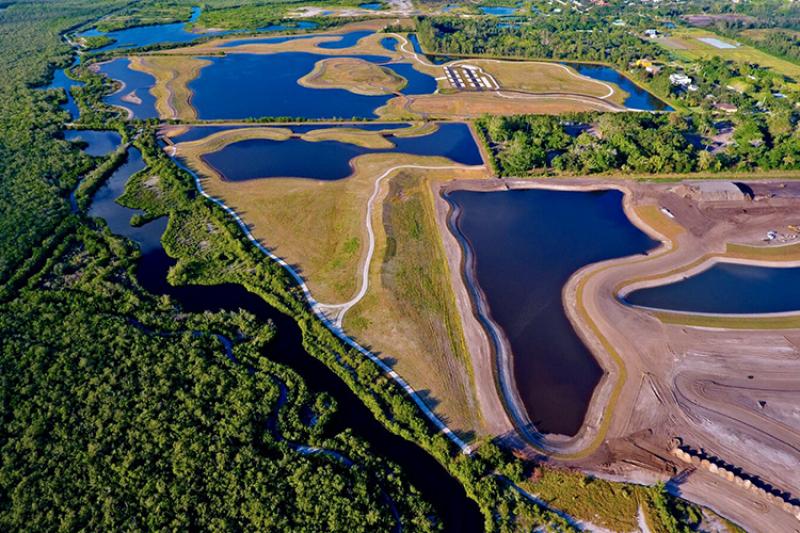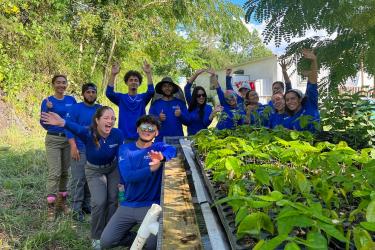Nestled near Tampa Bay in Bradenton, Florida, Robinson Preserve is a popular destination for nature lovers, with opportunities for hiking, kayaking, fishing, bird watching, and more. It’s also the site of a multi-million dollar habitat restoration effort, where NOAA and partners have been working to restore coastal wetlands, mangroves, and other habitat for fish. In particular, the restoration focuses on habitat for Florida fisheries that are popular with saltwater anglers. Ongoing monitoring and research will help us better understand how this restoration work is affecting recreational fisheries and benefiting the local community.
Restoring Habitat for Fish
Formerly abandoned farmland, the 482-acre Robinson Preserve property had been slated for development until Manatee County acquired the land in 2003. The county led an effort to restore wetland habitat, remove invasive species, and plant native vegetation at the site. NOAA helped support the restoration through our Community-based Restoration Program, alongside other partners. This first phase of restoration was completed and opened to the public in 2008. Robinson Preserve quickly became a favorite destination for wildlife and people alike.
A few years after the first round of restoration, an additional donation of land expanded the preserve by 150 acres—and provided another opportunity to restore habitat. With funding through the RESTORE Council, NOAA and partners restored close to 135 acres of coastal habitat, including shellfish habitat, seagrasses, mangroves, and salt- and freshwater wetlands. The project was one of five NOAA has supported under Connecting Coastal Waters, an initiative that restores Gulf coast wetlands under the RESTORE Act after the 2010 Deepwater Horizon oil spill.
The second phase of restoration focused largely on habitat to support popular Florida sport fish, including common snook and tarpon. Juveniles in particular rely on the calm waters found in coastal wetlands and mangroves. Fisheries biologists, restoration ecologists, and civil engineers designed features that would help protect juvenile fish from predators. For example, the project created areas with limited connection to the open waters of the estuary. It also planted mangroves in strategic locations to make it more challenging for larger fish to enter. By minimizing the number of large fish predators entering the nursery, these features provided areas where juveniles could thrive. In the end, the project created a haven of habitat that seemed perfect for fish—but would it be successful?
Measuring Restoration Success
Scientists can monitor a range of elements to help measure the success of a restoration project. These include what species and how many of them are using the habitat before and after restoration. But the effects of restoration don’t show up overnight—it can take years for the habitats and the species using them to recover. The time, capacity, and resources required to measure a project’s effectiveness may not always be available.
“Expense is often a barrier to long-term monitoring programs,” said Kris Kaufman, marine habitat restoration specialist with the NOAA Restoration Center. “To be able to build out a partnership for a longer term program is really a unique opportunity.”
As NOAA’s technical monitor for the Robinson Preserve restoration project, Kaufman has been involved in the project since 2017. NOAA’s technical experts work closely with our habitat restoration partners to provide assistance in navigating all aspects of a restoration project, from planning and design, to environmental compliance, and more. We use our depth of experience to help our partners overcome challenges and build solutions that support fisheries and coastal communities.
Kaufman began working with partners to explore options for additional funding to build a monitoring program for the Robinson Preserve project. Her efforts helped secure funding from NOAA Fisheries, the RESTORE Council, and Florida Fish and Wildlife Conservation Commission to support long-term monitoring. Researchers are working to gather and analyze data that will help them better understand how the restoration is affecting fisheries, the hydrology of the wetlands, and the local community.
“Historically in the Tampa Bay area, the primary focus of restoration has been building wetlands and improving water quality. The thought is that if you build it, the fish will come,” said Kaufman. “We’ve now had this opportunity to invest in a fisheries-focused design, to make sure the habitats are optimal and protective of fish, and that gives us a huge motivation for a strong fisheries monitoring program.”
Promising Early Results
With post-restoration monitoring now in its second year, researchers are still actively gathering data at Robinson. Manatee County has also received funding to extend the fisheries monitoring for another 2 years. But preliminary results have shown that juvenile snook and red drum are abundant in the areas specifically created as sport fish nurseries. Those protected areas were created with limited connection to the open waters of the estuary, minimizing the number of large fish predators entering the nursery. Elsewhere in Robinson Preserve, researchers have also recorded juvenile tarpon, sheepshead, black drum, and goliath grouper.
The project is already serving as a case study for others in the habitat restoration field. In September, a group of restoration practitioners attended a workshop at the preserve to learn about how to apply lessons learned at Robinson Preserve to their own habitat restoration projects.
“Tampa Bay has a rich history of habitat restoration, of experts who have been doing this work for years. But because of new and emerging issues like climate change, we’re having to transition to focus on new outcomes and develop new designs,” said Kaufman. “Robinson has a mosaic of habitats—from seagrasses to coastal uplands—which makes it a great location for sharing lessons learned.”
Partners
The habitat restoration, monitoring, and outreach efforts at Robinson Preserve has involved many partners, including:
- RESTORE Council
- Manatee County
- National Fish and Wildlife Foundation
- Florida Fish and Wildlife Conservation Commission
- Mote Marine Laboratory & Aquarium
- Tampa Bay Estuary Program
- Southwest Florida Water Management District
- Oyster River Ecology, Inc.



